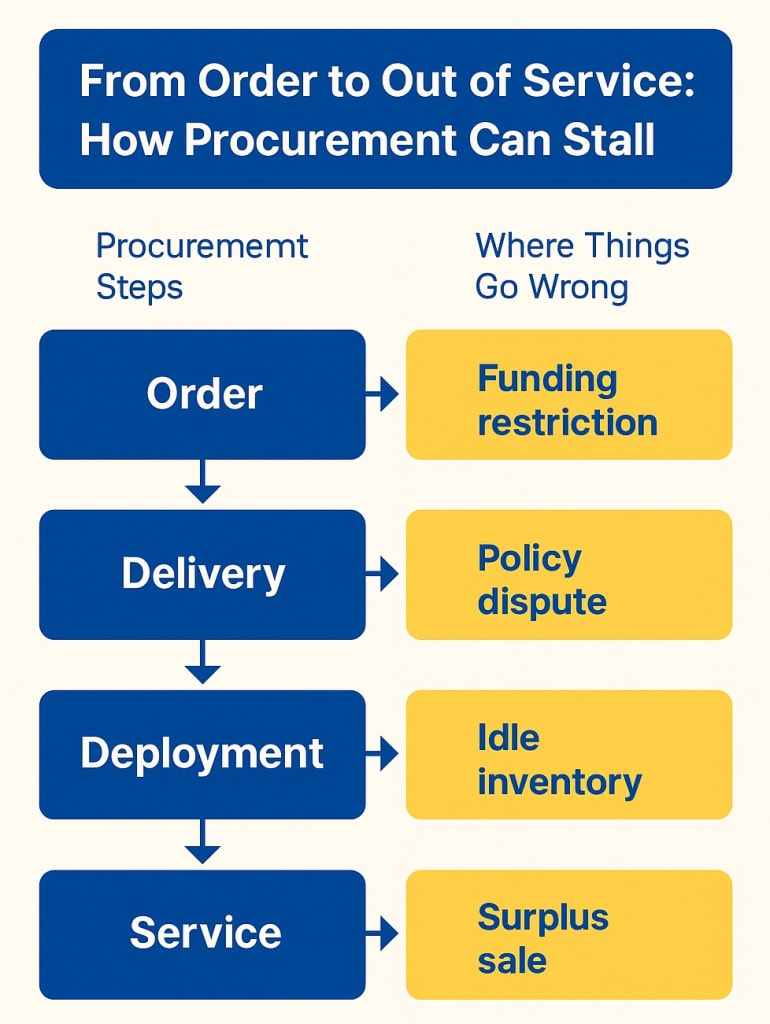In Oakland, California, 37 new police vehicles ordered a year ago are still parked at a dealership. The city had a budget allocated, but a dispute erupted over whether the “equipment services fund,” historically used for maintenance, is legally allowed to finance a purchase.
City finance officials point out that portions of that fund derive from federal grants, which may restrict capital uses. Meanwhile, the police department argues it should be permitted.
Without a resolution, the vehicles remain idle while the city continues to support an older, less efficient fleet.
That story first made headlines earlier in 2025, and it’s still unfolding. It’s a clear example of how tricky it can be for local governments to balance asset management, budgeting, and internal policies.
Why This Matters
If you’re a municipal staffer, equipment buyer, or someone watching how governments use resources:
-
- Funding strings can block deployment, even after procurement is approved.
- Idle assets are expensive, such as insurance, depreciation, and underutilized capital.
- Without transparent processes and clear policy, even well-intended purchases can stall.
- And sometimes that delay leads to surplus opportunities, if orders are canceled or assets are reclassified.

Key Takeaways & Practical Lessons
Know your funding sources and restrictions
If part of your funding comes from federal grants or matching programs, each dollar may have specific allowable use conditions — for operations vs capital. Map those restrictions before approving big spends.
Decouple procurement from deployment
Ordering vehicles is just step one. In Oakland’s case, the vehicles were delivered, but not integrated into operations. That delay increases costs and complexity (titles, outfitting, registration).
Monitor utilization closely
A brand-new vehicle parked for months is a liability. Track metrics like hours in service, miles driven, or calls fulfilled to ensure assets move quickly into use.
Build an exit/reallocation plan
If a project changes (funding, policy, or staffing), have plans to reassign, redeploy, or sell those assets before they become stranded, and make sure you’re following official surplus disposal procedures.
Clarify internal policies and spend authority
Finance, procurement, public safety, and asset management must coordinate. Dispute mechanisms and clear rules prevent hold-ups like those in Oakland.
Mini Case Study: Suppose This Happened in Your City
Imagine your city has buy-in for 20 new emergency vehicles, plus an equipment fund partially funded by grants. You:
-
- Confirm how grant terms apply (can you use the fund for acquisitions?).
- Design a deployment schedule so delivery, registration, and assignment are complete within 30 days.
- Reserve a small buffer for delays (title, outfitting, inspection).
- Institute a rule that any vehicle unused after three months is reviewed, reassigned, or prepared for sale.
That’s how you prevent a fleet of brand-new cars from sucker-punching you in your own lot.
Final Thoughts
Oakland’s case is a stark reminder: buying assets is only half the story. Deploying them effectively, within legal, financial, and policy constraints, is just as important.
For municipalities, this is about active stewardship, not passive ownership. For surplus buyers and contractors, it means “stranded” orders may eventually enter the auction pool.
Last Updated on October 10, 2025
